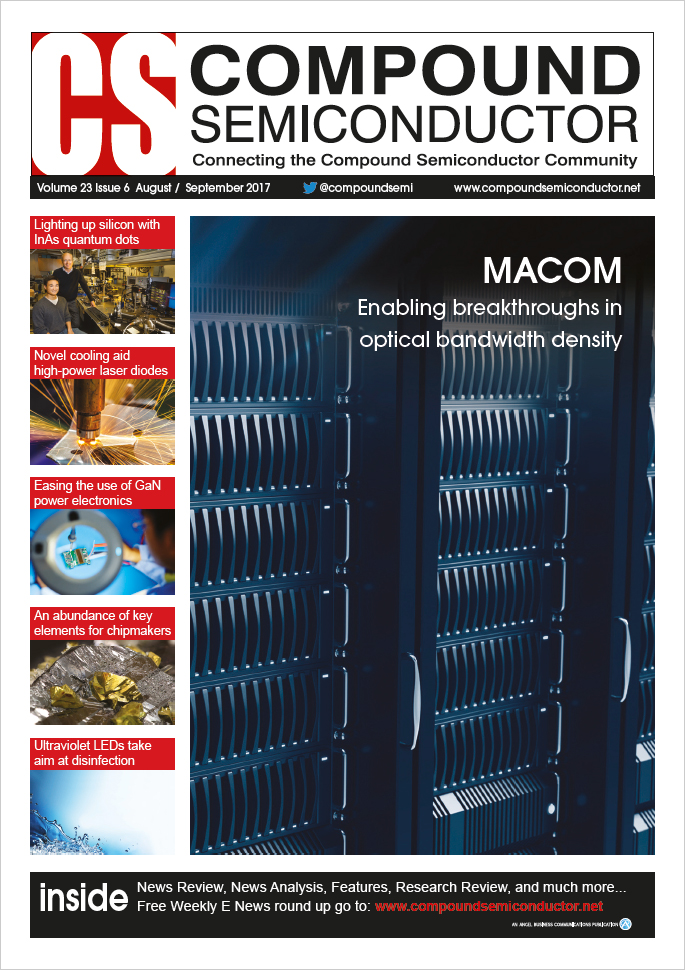
So, what do you do?

Do you dread trying to explain what we do as an industry? If so, try re-counting Bob Johnstone's new book on the LED lighting revolution
BY RICHARD STEVENSON
When you're introduced to someone new at a party, it will not be long before they'll be asking you what you do for a living.
Even if you've been asked this countless times before, it is not easy to know what to say. And it's particularly tough if you don't know their line of work: maybe they are technical, or maybe there not. So it might be best to begin by saying that you work in the compound semiconductor industry, and see what follows.
If they don't have a science or engineering background, you'll probably draw a look that convinces you that you've lost them. But you can probably regain their interest by mentioning the LED light bulb, the new kid on the block at their local hardware store.
Assuming that works, it is definitely not the time to tell them about two hotly debated issues within our industry: the green gap and the cause of droop. Discussing the quantum confined Stark effect, Auger recombination and electron spillover is likely to bore them to tears "“ and will do nothing to promote the importance of our industry.
Far better is to tell the story of the evolution of the LED. Not easy, maybe, but fortunately we'll assume that you are up to the task, having just read Bob Johnstone's latest book: L.E.D. A History of the Future of Lighting.
Before you can start you are asked if the LEDs used in the portable radios and stereos of yesteryear have anything to do with today's lighting.
Recalling parts of Johnstone's book, you offer a compelling answer. You point out that back in the 1990s the prevailing view within the LED industry was that these devices would only ever be indicators, despite their increasing efficiency; and makers of light bulbs didn't see LEDs coming. In that era it took a visionary to see the potential of the LED as a source of lighting.
Telling the tale of the transformation of the LED is easy after reading Johnstone's book. You engage your companion with a description of the visit in the early 1990s of Roland Haitz, head of Hewlett Packard's Semiconductor Products Group that made leading LEDs, to Ton Begemann at Philips. At the time Philips was a world-leading lightbulb manufacturer, with Begemann tasked with identifying technology trends.
You explain that during the meeting Haitz had a tour of Philip's Lighting Laboratory. Haitz, an expert in LED manufacturing, knew nothing about lighting "“ but he was learning fast. And while he learnt from Begemann, Begemann badgered him for details of current LED efficiency, and how fast it was improving.
These questions got Haitz thinking, and it was not long before he dug out a couple of decades of historical performance data. Plots revealed that with the passing of every decade there is a ten-fold reduction in the price per lumen and a twenty-fold hike in output power. Extrapolation indicated that LEDs would be competitive with conventional lighting by 2005.
At that point Haitz started to consider the energy savings that could result from a switch to LED lighting. The gains were phenomenal. In the US, replacing just half of the incandescent and halogen bulbs with LEDs would trim annual electricity bills by nearly $10 billion.
However, making this happen would not be easy. Haitz figured out that it would take billions of dollars of investment in the LED industry, and that was only going to happen if efforts were backed by government funding.
"But why would the government bother", argues your companion. "Don't you remember those fluorescent bulbs. Not great, but there were efficient, weren't they?"
You agree, but point out their many weaknesses. They were bulky, early products produced a ghoulish green blue light that put many customers off for good,
and they flickered "“ possibly causing migraines. What's more, they were incompatible with dimmer switches.
Johnstone points out that to prevent poor products from thwarting sales of LEDs, and to accelerate the development of this technology, the US government launched a competition known as the L-prize. To net $10 million and the kudos that went with it, the winner had to produce a bulb that combined many of the appealing attributes of the 60 W incandescent, such as its particular colour, with drawing less than 10 W and lasting for 25,000 hours "“ about 15 years "“ rather than 1,000.
You go on to explain that Philips won the competition, before going on to launch the bulb. At $50 a pop it wasn't going to appeal to the masses, but through refinements and competition, prices have tumbled. You say that last time you looked, a four pack of Philips 60 W-equivalent LEDs from Home Depot would set you back less than $10.
And it's not just in homes where LEDs are making a difference. Recounting one of the stories in Johnstone's book, you mention the success of LEDs in streetlights. In particular, you recall the statistic of 96,000 lights being tested over five years, with no failures whatsoever.
"Wow, that's impressive," says your companion. "But with such long lifetimes, is anybody making any money?"
L.E.D. A History of the Future of Lighting is written by Bob Johnstone and published in May 2017 by the CreateSpace Independent Publishing Platform.
That's a perceptive, painful question. You have to admit that it's a bit of a blood bath right now "“ it's even got its own name, illumigeddon. What's not helped is a glut of LEDs made for backlighting TVs, tablets and laptops, leading to more chips for sale for lighting.
As you dwell on this, you're asked: "Is that light up there powered by an LED?"
It is, you reply, as you gaze at what is beyond doubt a rather fine fixture. It enthuses you, and you explain that sales of LEDs used in lighting fixtures offers longer term growth and better margins. Before you continue, a fine plate of hors d'oeuvres appears in front of you.
The bright cherry tomatoes, out-of-season, remind you of another application of the LED described by Johnstone: agricultural lighting. Not only is the lighting more efficient, saving money, but the colour can be tuned to be as effective as possible, allowing a lengthening of the growing season.
"I can see that getting the lighting just right is good for plants, but you can't beat sunshine for making you feel good, can you?"
You nod in approval, impressed by such awareness of the impact of light. You mention that earlier this year Lufthansa had fitted tuneable LED lighting in its latest Airbus 380 super-jumbo to give the right light at the right time. That's warm light for relaxation, and cooler light for passengers to work.
Tailored lighting can also help children to learn better, you add, according to a study recounted in Johnstone's book. When Philips installed a dynamic lighting system in schools that had four settings "“ using differences in intensity and colour to either invigorate students, help them to focus, or aid relaxation "“ the results were very impressive. Reading speed increased by one-third, and hyperactive behaviour declined by more than 75 percent.
You point out that encouraging results have also come from trials in care homes. But this field is still in its infancy, with much more work needed before any claims of the health benefits of LEDs can be justified. However, you point out that whatever the outcome, it is fun to be able to control the colour of the lights in your home.
"Yes, I can see that. And I'm just about to buy a rundown apartment that will need gutting. Maybe now is the time for me to embark on installing an LED lit home."
At this point you are tempted to encourage them, arguing that it is definitely the way forward. But then you remember the epilogue in the book, a cautionary tale of Johnstone paying for an installation of LED lighting during the refurbishment of his loft apartment.
While the final results were a success, the installation was a nightmare. The architect didn't trust the lighting designer, the electrician was not proficient with the technology, and attempts to prevent the budget from getting out of hand by securing cheaper products led to delays and compromise. A new electrician had to be appointed to complete the job.
While they thank you for your honest advice, you get a tap on your shoulder. You turn to see that it's the host of the party that wants your attention.
"I've got someone I want you to meet. They've been telling me that they've been stock-pilling incandescent bulbs, because all the alternatives are no good. I'm sure you convinced me to get that LED bulb in the hall. Can you talk to them?"
Off you go to shake their hand and put them straight, armed with a few more anecdotes from Johnstone's book.


































